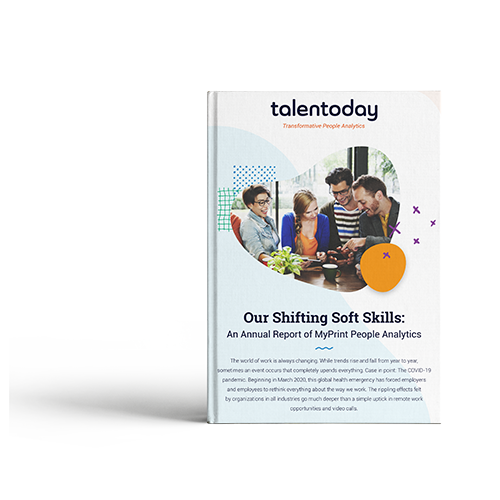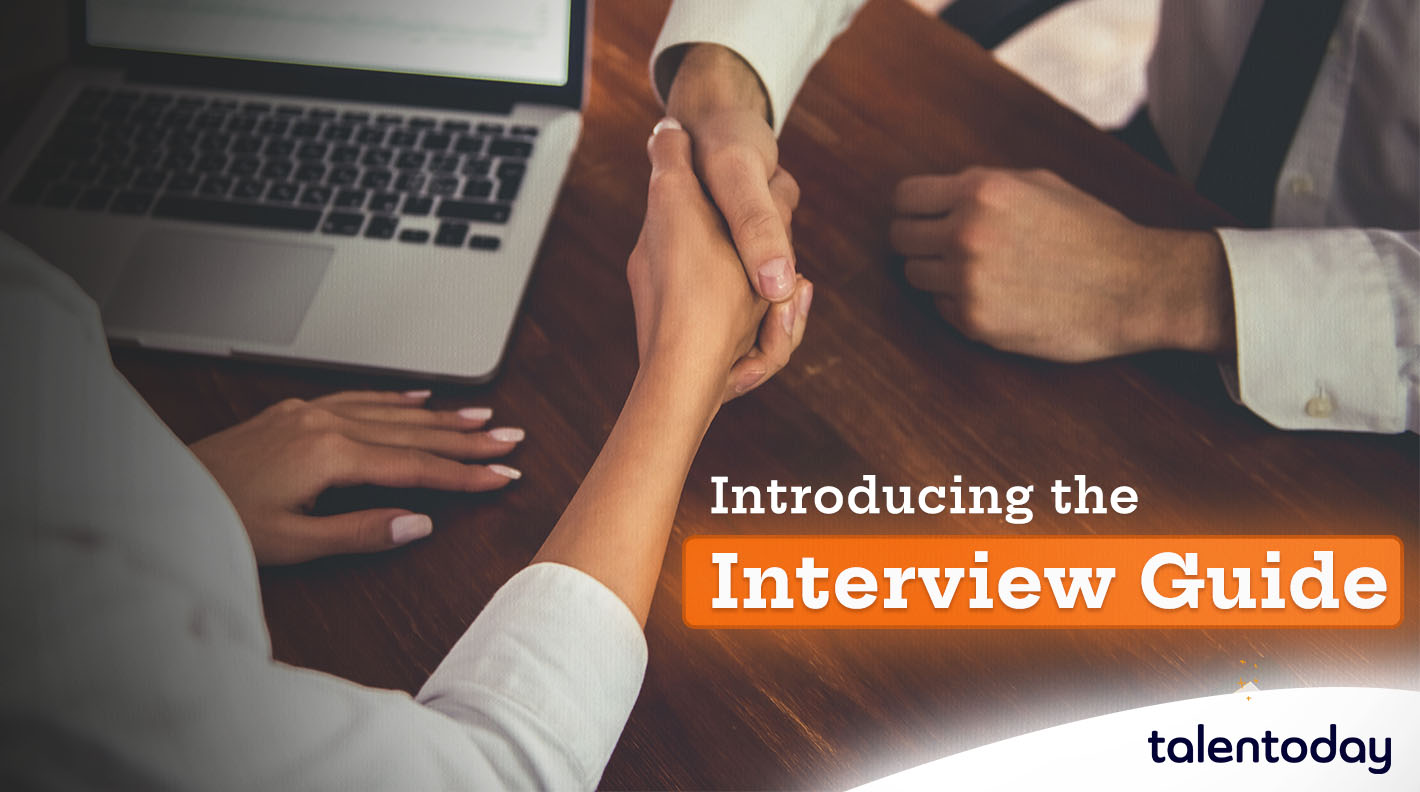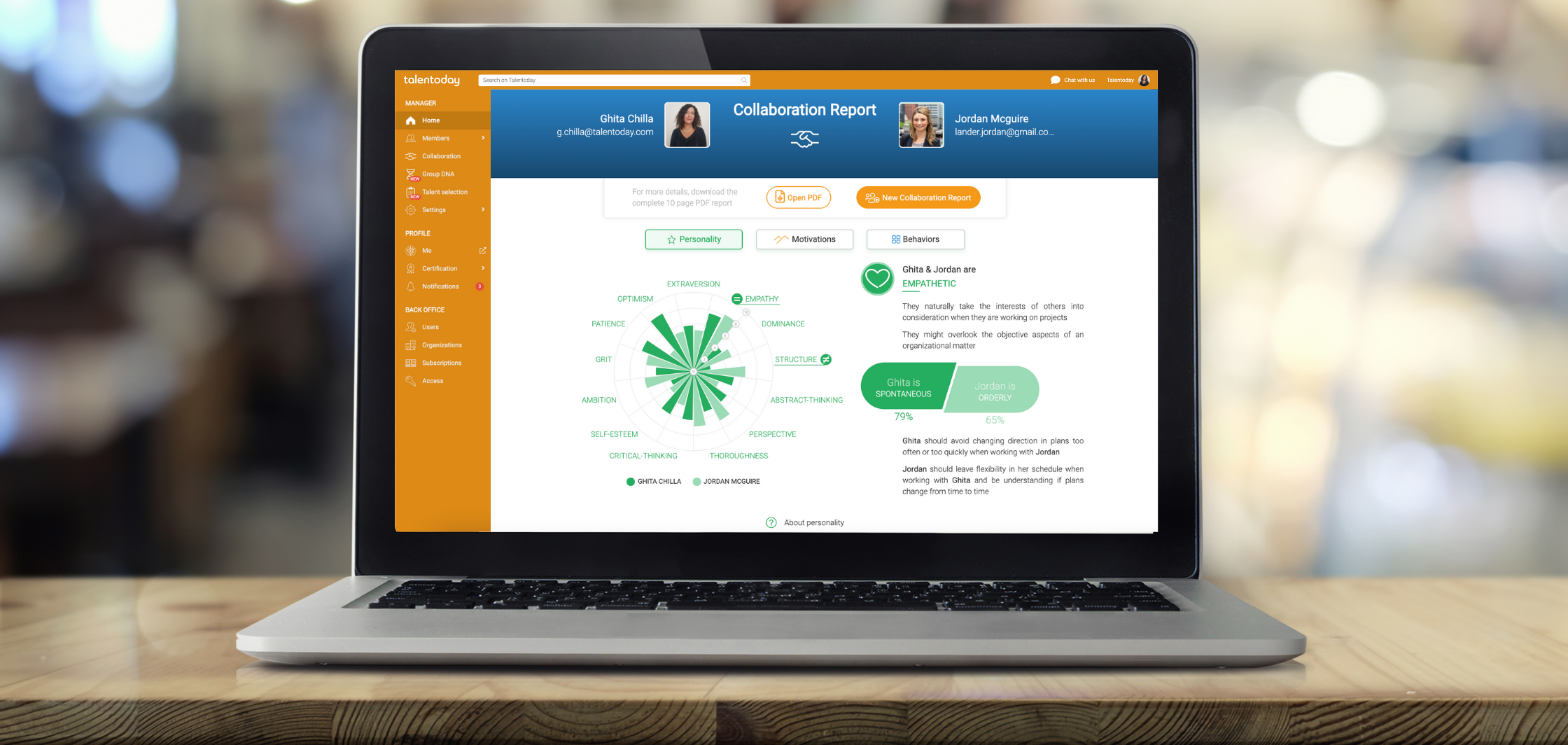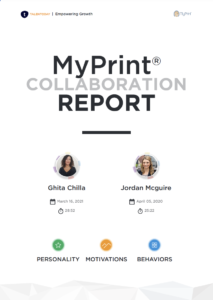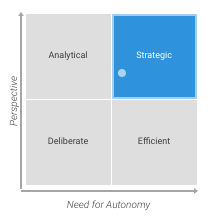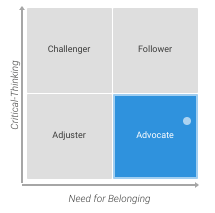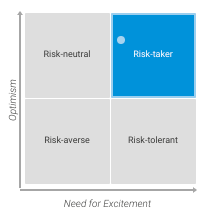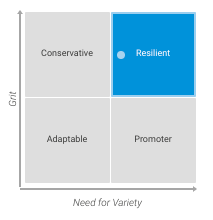Our Shifting Soft Skills: An Annual Report of MyPrint People Analytics
The world of work is always changing. However, in the last two years, organizations in all industries have to rethink everything about the way we work.
How have your employees changed? Are you ready to adapt your processes to meet their evolving needs?
Learn how to embrace personalized solutions that are driven by the latest soft skills data and tailored to the changing personalities and motivations of the workforce.
Utilizing MyPrint personality assessment results gathered from the start of the COVID-19 pandemic, this report investigates:
- 6 Soft Skills on the Rise
From increased autonomy to a need for more variety, what is driving employees to succeed? - 6 Soft Skills on the Decline
What impact will lower levels of skills like grit and empathy have on your team? - The Effects on Workplace Behaviors
Leadership, work and learning styles are all changing alongside our shifting soft skills.
Click here to download our report detailing the soft skills trends making an impact in the workplace.
The Soft Skills DNA of Remote Workers
Remote workers have taken on growing significance in the U.S. workforce. In fact, a recent poll of employees showed that 39 percent would now consider quitting if their bosses did not provide some sort of work from home option. Clearly, employers need to take remote work seriously as they ponder how to build teams with the future of work in mind.
While remote work had been growing in popularity prior to the COVID-19 pandemic, the global health crisis turned work from home from a nice-to-have option into a necessity for a great deal of companies. The experience highlighted the advantages of a more flexible work environment for many employees and employers alike. However, as with any workplace, some workers adapted more easily to remote working conditions than others. The reason for these differences can be found in the science behind personality traits and workplace motivations.
Remote Work DNA
In an effort to help employers better understand this emerging workforce, psychologists at Talentoday used our Tailored Group DNA tool to create a soft skills model dedicated to remote workers. Users who access this tool within the Talentoday Manager platform will find the predominant personality traits and motivational needs that are necessary for a good adaptation to remote working conditions. Employers can then use this information to compare these benchmarks with the profiles of existing employees and potential job candidates.
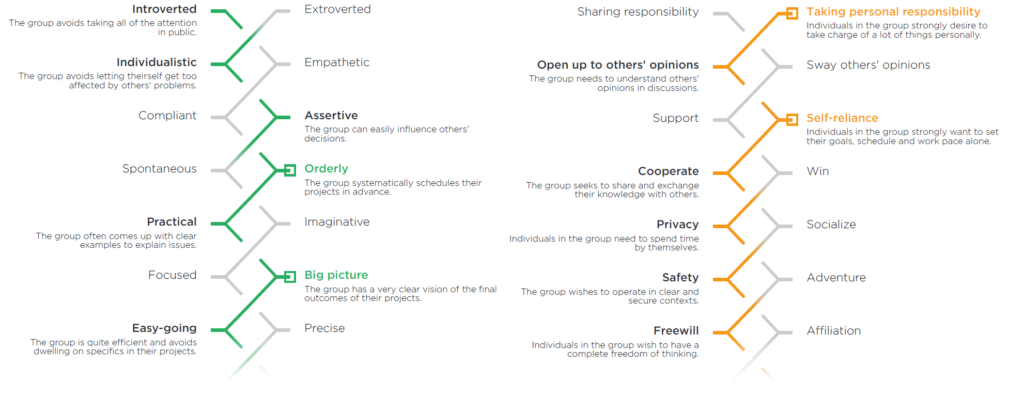
Here’s a preview of our findings:
Predominant Personality Traits
- Orderly: When working from home, it pays to stay organized! This group prefers to schedule projects in advance.
- Big Picture: Even if the home office might be small, the goals for this group are big. Remote workers are more likely to have a clear vision of the final goals of their projects.
- Determined: This group sticks it out when the going gets tough, striving to overcome even the most difficult challenges.
- Positive: A shifting work environment is helped by the right mindset. These individuals have strong confidence in the future.
Predominant Motivations
- Taking Personal Responsibility: Remote workers know that they are the only ones around to hold them responsible for their actions. They tend to keep themselves accountable for their work and decisions.
- Self-Reliance: When you work from home, it pays to be able to set your own goals, schedule and pace of work.
- Personal Achievement: Goal setting is essential when it comes to the flexible work environment. Our research shows this group seeking to achieve highly difficult objectives.
- Intrinsic Enjoyment: When you work alone most of the time, you tend to find motivation from internal forces. Rather than being showered with external accolades, these workers prefer to achieve things for their personal satisfaction.
If recent history is any indication, remote work and other flexible forms of employment are here to stay. Employers looking to build the best teams possible need to start considering more than technical requirements for positions. By applying soft skills research to the hiring and team management process, employers can better predict employee success in a given workplace setting.
Are you interested in learning more about Group DNA from Talentoday? Click here to sign up for your free trial of Talentoday Manager, which includes our Group DNA tailored to the needs of the remote workforce.
Ask the Right Questions with Talentoday’s Interview Guide
Resumes are the best tools available to hiring managers for evaluating candidates’ hard skills. However, it’s becoming increasingly clear that the likelihood of success in a job is dependent on more than just technical qualifications alone. In fact, according to a LinkedIn Global Talent Trends report, “89 percent of recruiters say when a hire doesn’t work out, it usually comes down to a lack of soft skills.” That’s why Talentoday has introduced our Interview Guide, a new tool designed to improve the job interview process with a candidate’s soft skills in mind.
Introducing the Talentoday Interview Guide
Talentoday’s Interview Guide is generated based on an individual’s MyPrint results. After a job candidate completes their soft skills assessment, hiring managers can now access sample interview questions based on behavioral work styles, including:
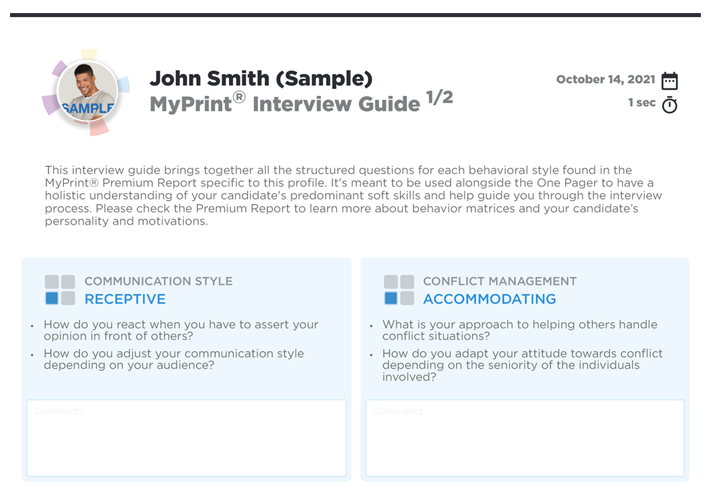
- Learning Style
- Conflict Management
- Communication
- Decision Making
- Work Style
- Leadership Style
- Creativity
- Risk Orientation
- Team Participation
- Change Reaction
- Rule Consciousness
In short, our Interview Guide brings together key structured questions for all of the behavioral styles found in the MyPrint results specific to a candidate's profile in one easy-to-use format.
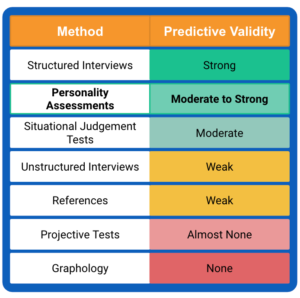
How to Use the Interview Guide
This guide is meant to be used alongside the MyPrint One Pager report in order to provide holistic understanding of a candidate's predominant soft skills and help to inform the interview process.
The sample questions provided allow hiring managers to go above and beyond the analysis of the soft skills results in order to zero in on behavioral takeaways. They can help interviews to identify the behaviors that are most relevant to the job description, then support the process of asking for relevant and concrete examples from previous professional experiences. The questions generated in the Interview Guide can be used both in behavioral and structured interview designs.
It’s important to note that the results provided for each candidate should not be utilized as a coaching tool; it is not for those being evaluated, but for the evaluator! Whether being used to gain insight during recruiting interviews or to support development during the annual review process, the interview guide acts as a tool to support decision making driven by the science of soft skills.
Ready to Get Started?
If you’re ready to gain a deeper understanding of your job candidates and improve decision making by asking the right questions, click here to learn more about Talentoday’s Interview Guide. Then, experience Talentoday’s people analytics for yourself by signing up for a free trial.
Rethinking Retention and Reining in the Great Resignation
If you’re an HR professional, you are well aware of the stats by now. A majority of employees (65 percent, according to PwC) are on record saying that they are at least entertaining the idea of leaving their workplace for a new job. This August, a record 4.3 million workers actually took the leap and quit their jobs. In short, businesses in all industries are facing an employee retention crisis.
The question is no longer, “Is the Great Resignation really happening?” In the wake of the effects of COVID-19 and the economic uncertainty that has come with it, the U.S. workforce has answered that question with a resounding, “Yes!” For organizations looking to stabilize their teams, the billion dollar question now is, “How do we rein in our great resignation with a healthy dose of great retention?”
One thing is clear: The old ideas for keeping employees engaged and employed simply are not cutting it anymore. Thankfully, three building blocks for rethinking retention - identifying what makes your situation unique, reevaluating career paths and getting creative - provide a starting point for leaders in need of continuity in their workforce.
Identify What Makes Your Situation Unique
The Great Resignation may be a catchy name, but lumping together millions of life-altering career decisions into one neat package can be misleading. Buried within the shocking statistics and clickable headlines are millions of individual personalities, motivations and behaviors driving these choices. The reasons for increased turnover can vary widely from company to company, team to team and person to person. Therefore, it’s important to zero-in on what makes your situation unique.
Employing quick-fix solutions, like increasing compensation for particular high-turnover roles, may be tempting, but can also prove to be short-lived in effectiveness. Instead, consider utilizing company-wide surveying and soft skill assessments. These scientific tools can give leaders measurable insight into what’s driving change, as well as what might be more likely to encourage employees at a team and individual level. After all, if the factors driving employees to leave aren’t one-size-fits-all, why would a single solution get retention back on track?
Reevaluate Career Paths in a Changing Workplace
A recent survey commissioned by The Conference Board revealed that 58 percent of talent acquisition and HR leaders report that their employees are concerned about upward mobility if they are not physically in the workplace. These results highlight that the disconnect from the shift to remote and hybrid workplaces runs much deeper than missing out on water cooler conversations; employees are increasingly losing a grasp on the opportunities for growth available to them within their organizations. If employees cannot see a future for themselves where they’re currently at, it stands to reason that they’d look elsewhere for fulfillment.
How can companies counteract resignations stemming from this disconnect? The report goes on to recommend that organizations reward leaders for facilitating internal movement of employees, develop a cross-functional talent mobility program and find ways to give virtual employees added exposure to these opportunities for mobility. The motivations that drive an individual’s career decisions naturally change overtime. For better or worse, the COVID-19 pandemic has accelerated these changes for many people. Before losing talent to greener pastures elsewhere, leaders need to provide their employees with opportunities for upskilling, growth and lateral moves internally.
Get Creative Early and Often
When an employee decides it’s time to move on, there are plenty of options available to organizations trying to find ways to keep the talent in-house. While money can be enticing for many employees, it’s not a panacea (and some organizations simply cannot withstand a counter-offer war for top talent given their current financial situation.) It’s time for companies to become creative when finding ways to retain employees. Using people analytics derived from surveying and soft skills assessments, HR professionals can better identify incentives that are personalized to the individual. For example, while an increased annual salary might be a key driver for one employee, more flexibility in scheduling and work environment might rank higher for another.
However, one major takeaway for the HR Community in light of the Great Resignation should be that preventative measures need to be taken before workers begin to leave en masse. Let your creativity shine long before it needs to be used in a last-ditch effort to hold onto employees! According to Inc.com, some CEOs have begun relying on exercises such as “anything but work” check-ins, gratitude sharing sessions and games to connect with employees on a personal level in the era of hybrid work.
Will these efforts help boost your organization’s employee retention in the face of the Great Resignation? The only way to know is by building personalized solutions tailored to the needs of each employee. Otherwise, you'll be resigned to riding a rising tide of turnover.
Are you ready to identify what motivates your candidates and employees? Experience how MyPrint can uncover a better way to hire and retain a top team by clicking here!
Understanding the Difference Between Intrinsic and Extrinsic Motivations
When it comes to motivating employees, one size does not fit all. For some people, the thrill of competition for hitting or exceeding key metrics, like number of sales per quarter, gets them excited. For others, discovering the best way to complete a given task, such as finding the most efficient solution for cold calling, might be a source of inspiration. No matter how it happens, employers recognize that maintaining employee motivation is key for sustaining success - especially in hybrid and remote work environments.
Before launching new programs aimed at motivating a workforce, it’s important to first understand the nature and types of motivations that exist. Then, tailor those available options to meet the unique needs of each employee.
Why is Motivation Essential?
Obviously, employing and supporting a motivated workforce should be a priority for all organizations. However, the effects of the COVID-19 pandemic have shown us just how valuable it is to have a varied approach to motivation.
For example, a recent survey from Jostle of 400 employees who shifted to remote work in the past year revealed that a whopping 83 percent of individuals reported feeling disconnected from their workplace culture. While productivity may not have dipped in the short term, the fact that a majority of respondents also noted feeling less supported by managers during this time makes it clear that these results in output are not sustainable over the long-term.
As the way we work changes, so too must the way that managers motivate their teams. As organizations embrace a hybrid approach to work, combining virtual and in-person elements, it’s time to look at motivational practices in the same way.
To get to the heart of the motivation question, here is the first question every manager must ask: Are my employees driven by intrinsic or extrinsic motivations?
Intrinsic or Extrinsic Motivations
To start, the concept of separating out intrinsic and extrinsic motivations is a fairly straightforward - yet essential - exercise. According to Psychology Today, “intrinsic motivation refers to those activities you do because you enjoy the activity itself,” whereas extrinsic motivations refer to anything we do because of reasons outside of the work. Extrinsic motivators include salary, job perks/benefits, status and work conditions. Intrinsic motivators include things like recognition, challenging work, purposeful work, achievement and opportunities for personal growth.
Consider the examples mentioned at the start of this piece. A sales team competing for top spot on the quarterly metrics tracker would be a textbook example of an extrinsic motivation. Even though making sales might be related to the job at hand, taking first place in this competition is a motivation tied to results, not the tasks of the job itself. On the other hand, an employee might find joy in the actual process of selling. For example, the step-by-step journey of finding the best times to make outreach and most effective scripts might be exciting in its own right.
For those motivated intrinsically or extrinsically, there are a variety of ways employers can meet their needs with tailored solutions. Here are the forms of intrinsic and extrinsic motivations identified by the MyPrint soft skills assessment:
Intrinsic
- Responsibility: This motivation dimension refers to the extent that a person seeks to feel accountable. While some individuals find joy in making big decisions for their teams, others would like to share that responsibility with others.
- Influence: This motivation dimension refers to the extent that a person seeks to influence others’ opinions and intentions. Those that are highly motivated by influence enjoy swaying others’ opinions, while those that are lower on this motivation dimension are happiest when they can stay open-minded to different points of view.
- Belonging: This motivation dimension refers to the extent to which a person wishes to be part of a group. Individuals who are highly motivated by belonging seek to find common interests and hobbies with their coworkers to create a team feeling, whereas other individuals like to keep their interests or opinions independent from the rest of the group.
- Challenge: This motivation dimension refers to the extent that a person seeks to get out of their comfort zone. Those that are highly motivated by challenge will always try to outperform their previous goals and achievements, whereas those that are not as motivated by challenge are content working towards attainable goals.
- Recognition (Intrinsic enjoyment): Those that are on the lower end of the recognition dimension are seeking intrinsic enjoyment. They seek out projects and tasks that they enjoy doing, even if they are not receiving any external recognition for their work.
- Reward (Need to contribute to society): Those that are on the lower end of the reward dimension seek to work on projects that have an impact on society. They need to understand the greater impact of their work, regardless of the tangible benefits they might receive.
Extrinsic
- Autonomy: This motivation dimension refers to the extent to which one wishes to control their circumstances. Those that are highly motivated by autonomy like to set their own goals and schedule, whereas those who are lower on the autonomy dimension prefer to consult with others before setting their goals.
- Competition: This motivation dimension refers to the extent that an individual will seek to outperform others. Those that are highly motivated by competition like environments that encourage public performance metrics, whereas those that are lower on the competition scale will seek to share their knowledge to help work towards group goals.
- Relation: This motivation dimension refers to the extent to which an individual seeks to have multiple social contacts. Those that are high on this motivation dimension seek out opportunities to socialize as frequently as they can, whereas those who are lower on this dimension desire privacy in their work environment.
- Recognition (External acknowledgement): Those who are high on the recognition dimension seek positive feedback and compliments for a job well done. The external recognition is enough to keep them motivated, even if they do not necessarily enjoy the work they are doing.
- Reward (Tangible benefits): Those who are high on the reward dimension are motivated by having their performance rewarded by material benefits. They will often be encouraged to work harder when there are opportunities available.
- Excitement: This motivation dimension refers to the extent to which an individual is motivated by thrill. Those who are highly motivated by unpredictable environments and the opportunity to take risks, whereas those on the lower end of the excitement dimension prefer safe and predictable environments.
- Variety: This motivation dimension refers to the extent to which an individual seeks out new experiences. While some individuals seek out diverse experiences, projects, and skills, others prefer to stick to familiar routines and work methods.
Motivating and Moving Forward
Gone are the days of ordering pizza into the office to celebrate a job well done and calling it a day. In the changing world of work, managers need to become more nuanced in the ways they motivate employees. To start reshaping these practices on a case-by-case basis, it’s important to identify whether an individual is driven by intrinsic or extrinsic motivations. Only then can managers determine which particular path is right for each employee.
Are you ready to identify what motivates your employees? Experience how MyPrint can uncover what makes you and your team unique by clicking here!
Why Upskilling is Crucial for Hybrid Teams

There were a lot of things I didn’t know I could do before COVID-19 upended the way we live and work. For example, I already knew my way around the kitchen, but I had no idea I could make tasty banana bread! I also learned how to cook a spicy jambalaya, brew my own beer and, when I wasn’t eating or drinking, I figured out how to use a 35mm film camera to expand upon my interest in photography. In my home life, I would call these achievements “little victories.” Little did I know that, were I to do the same sort of expanding of my talents in the workplace, it would be known as “upskilling.”
Upskilling is the process of using training and education to deepen an employees’ abilities within their area of expertise. This is slightly different from reskilling, which is when an employee is trained on an entirely new skill set in order to move into a different role. Instead, upskilling is all about building upon an employee’s existing skills in hopes of enhancing their impact on an organization.
While my personal upskilling may not have major implications for the workplace (even if some morning meetings are greatly improved by the addition of banana bread), upskilling has the potential to reshape the way organizations recruit and develop talent – especially as teams embrace hybrid work models.
The Skills Gap Continues to Expand
As the modern workplace undergoes unprecedented changes, existing skills gaps across all industries are widening. While employees may have entered into the workforce with skills that were in high demand at the time, the rate of digital transformation has increased sharply in response to the COVID-19 pandemic, leaving many of these employees behind. According to McKinsey & Company, 87 percent of companies say they have skills gaps or expect to within a few years. Jobs are changing fast, and employers and employees are struggling to keep up.
There are a few options at organizations’ disposal for dealing with these gaps in needed competencies. In less competitive hiring markets, one appealing course of action would be to bring in new talent to fit the needs. However, today’s recruiting landscape is characterized by a dwindling supply of talent and an aggressive influx of demand from employers. These conditions have forced many employers to look inwards when determining how to address their skills gaps in the years ahead.
Employees are Looking for a Change
To exacerbate the problem even further, this expanding skills gap comes at a time when workers are beginning to quit jobs at extraordinary levels. In April 2021, the number of employees leaving their companies spiked to approximately 4 million according to the Bureau of Labor Statistics (BLS), leading many to refer to the phenomenon as, “The Great Resignation.”
In truth, does anyone ever really want to be forced to find a new job? In the same way that employers would rather retain talent than search for replacements, employees are hoping for reasons to stay at their current organizations before making a drastic move. Take the results of a recent PwC survey into consideration. Their findings show that the majority of workers are open to change, citing that 40 percent of respondents successfully improved their digital skills during the pandemic and over 90 percent of those who adapted to remote work would prefer to continue working in this style of environment. On top of that, 77 percent of workers are ready to learn new skills.
The issue is not a lack of willingness to learn on the side of employees but, rather, the lack of opportunities for upskilling offered by employers. However, if organizations are serious about closing their skills gap and retaining employees in the face of an explosion of resignations, it’s time to make learning and development programs a real priority.
Make Upskilling a Priority
While employers seem to recognize the problem they face, there remains a gap between this recognition and an understanding of how to address the underlying causes. According to a 2021 survey conducted by Gartner, 68 percent of HR leaders cited building critical skills as a top priority. However, more than 30 percent of the same leaders say that they don’t know what skills gap their employees have, how to effectively integrate learning into employee workflows or can’t create skill development solutions fast enough to meet evolving skill needs. In short, employers know there are skills gaps to address, but are uncertain where they lie or how to fix them.
The way forward is two-pronged, based first on assessment then solidified with commitment:
- Assessment: First and foremost, organizations need to utilize tools to empower them to better evaluate their candidates and employees. Knowing the current capabilities of a team is important, but identifying the potential for growth can be critical. While necessary technical skills can be assessed through traditional means, such as verifying education and certification backgrounds, this must be coupled with a deeper understanding of soft skills. Scientifically-based soft skills assessments can provide insight into an individual’s capacity to upskill into a role over time.
- Commitment: Once the workforce has been properly assessed, organizations must then approach upskilling differently than standard onboarding and other job-specific training opportunities. Instead, upskilling opportunities must be treated like the valuable benefits they are. As noted in Fast Company, “For the top tier of talent, upskilling is emerging as a must-have employee benefit, like a retirement saving plan, employer subsidized health care, or paid time off.” In other words, these education programs cannot be haphazardly inserted into existing workflows. Rather, time and space must be set aside for employees to truly feel as though upskilling is a top priority.
As the way we work continues to change, teams are struggling to keep up. However, by devoting time and effort to upskilling programs, there are win-win solutions available for employers and employees alike.
Are you ready to evaluate your team’s soft skills to determine upskilling opportunities? Discover the powerful science of people analytics that drives MyPrint by clicking here.
How Culture Add Goes Beyond Culture Fit to Support Diversity, Equity and Inclusion in the Workplace
For years now, organizations have been stressing the importance of using company culture to drive recruitment and team management efforts. The theory being that hiring individuals that align with the elements that make up a company’s culture - like preferred work environment, company mission, leadership style, values, ethics, expectations and goals - will lead to a happier, more productive workforce.
It’s why most HR professionals have seen (or have had a hand in crafting) recruiting pitches like these:
“Be a part of a fast-paced team!”
“Join our values-driven organization!”
“Are you looking to work in a collaborative and creative environment? Apply now!”
While these culture-driven hiring efforts may be well meaning, there’s growing research indicating that making decisions based on “culture fit” alone may be missing a bigger point. Instead, the real key to unlocking a productive and diverse workforce may be what’s known as “culture add.”
What is Culture Fit?
To begin, hiring professionals need to assess how the industry has been operating in order to determine the best path forward. When culture fit first gained momentum in offices, the idea seemed both groundbreaking and simple. Instead of only relying on hard skills and job description qualifications when determining the best possible fit for a role, HR teams decided to go further. Now, how people go about their work was just as important as what they were doing. Since the style and approach required for being successful at one organization may not transfer to another, culture fit aims to assess whether a candidate’s attitude, motivation and values are aligned with the culture.
Where Does Culture Fit Fall Short?
Unfortunately, hiring for culture fit does not always add up to the ideal workforce its proponents claim to deliver. While the attention this methodology brought to historically under-evaluated areas of candidate profiles, such as personality, motivations and behaviors, was an improvement, it also led many hiring managers into a dangerous trap known as affinity bias. According to LinkedIn, “Affinity bias is the tendency to have a preference to people like ourselves. In hiring, affinity bias can mean leaning toward one candidate over another because they have a relatable background, belief, or appearance.” In other words, while organizations may have thought they were hiring the best candidates for the job thanks to how well they “fit” into a culture, they may have unknowingly been building a homogenous workforce lacking in true diversity. This same research goes on to note that inclusive companies are nearly two times more likely to be innovation leaders in their market, and these same companies outperform industry norms by an average of 35 percent.
Clearly, while hiring for culture fit can have its benefits, companies that do so may be leaving countless amazing hires behind due to rigid match criteria.
How is Culture Add Different?
Today, the practice of hiring for culture add aims to improve where culture fit strategies fall short. As a recent article in Fast Company puts it,” Assessing for culture fit can unintentionally encourage managers to pick candidates that look like everyone else. But looking for culture add helps managers to determine how a candidate’s individuality and differences can make a company better and stronger.” Rather than stifling the things that make a candidate unique, culture add aims to find ways to embrace that individuality within the existing framework of a company’s culture.
In truth, getting to this point can be challenging - especially for larger organizations with deeply ingrained cultures and hiring processes. Culture change takes time, and there needs to be top-to-bottom buy-in to ensure everyone moves in the right direction to embrace diversity, equity and inclusion at scale. LaFawn Davis, Vice President of Diversity, Inclusion and Belonging at Indeed.com, offers these best practices for companies looking to move towards culture add-based hiring:
- Empower recruiters to push back. When culture fit is given as the reason to decline an offer, recruiters should be able to ask follow-up questions to ensure this reasoning is not being used as an excuse to make decisions based on bias or emotion.
- Ask for more details. Sparking a deeper conversation about a hiring manager’s desired attributes and skills, and how the candidate may meet or miss these marks, could be another way to get beyond a cultural fit impasse.
- Use rubric-based scoring. Go beyond gut-feeling! Having a reliable scoring system can point to where candidates may have fallen short or, if the hiring manager can’t point to something specific, give the recruiter a reason for challenging biased thinking.
As organizations continue to recognize the importance of diversity, equity and inclusion in all industries and workplace settings, the concept of culture fit may be coming to an end. Instead of only hiring those who can fit themselves into a tidy box of strictly defined cultural norms, it’s time for human resource professionals to tap into the power of embracing what makes each of us truly unique.
After all, where’s the fun in just fitting in anyway?
Are you ready to build a diverse workforce through the power of science-driven people analytics? Discover the science behind MyPrint by clicking here.
Are Your Personality Traits Right for Your Career Path?
Long gone are the days of separating “life” and “work” into two separate buckets hoping to achieve some sort of balance. Employers and employees alike are now becoming increasingly aware that the personality traits that make each of us unique at home are the same things that can make us successful in the workplace. This shift has been highlighted as the effects of the COVID-19 pandemic further blur the line between professional and personal.
Now, instead of simply checking boxes of required technical abilities and education, job seekers are having to ask themselves deeper questions about their personalities. These questions can include:
“Am I more reserved around new people or do I feel at ease when I’m in the spotlight?”
“Am I comfortable when things are not organized or do I prefer instructions in unfamiliar situations?”
“Do I simply focus on getting a task done or do I take time to focus deeply on the details?”
This amount of self reflection can be overwhelming when there’s a ticking clock for finding work! How can job seekers better understand themselves in order to prepare for the new world of job searching? Thankfully, there is more information than ever to identify which personality traits are more likely to lead to success in a given career path.
Identifying Your Personality Traits
Most job seekers are familiar with the standard questions they’ll likely face in a job interview, such as, “What are your strengths/weaknesses?” However, it’s all too easy to fall into the trap of telling meandering stories that are heavy on details but light on proven takeaways.
What hiring managers are really looking for in job interview responses are what are known as, “transferable skills.” These are the types of skills that are not specific to a single industry or role. Rather, transferable skills — such as personality traits — can be used in a variety of settings.
In order to go deeper when identifying your transferable skills, consider taking an assessment backed by science, such as MyPrint®! Supporting anecdotal evidence from your experiences with tools built on data-driven people analytics can add credibility to your claims. Furthermore, the MyPrint assessment evaluates individuals on 13 distinct dimensions of personality, and gives information on 26 total personality traits. Pinpointing your personality traits can help narrow your job search to roles that are more likely to be the right fit for your career.
Popular Fields and Noteworthy Personality Traits
Once you have a better understanding of the personality traits that make you unique, it’s time to connect them to jobs that will allow them to shine! Based on our Talentoday user database, here are the key personality traits that align with 14 of the most in-demand career paths today:
- Administrative: Compliant, Structured, Conventional Thinker, Practical
- Art Design: Imaginative, Spontaneous, Critical-Thinker, Precise
- Education: Empathetic, Modest, Extroverted
- Engineering: Precise, Confident, Determined, Positive, Individualistic
- Finance/Bank/Accounting/Audit: Confident, Positive, Relaxed, Determined, Individualistic
- HR/Purchasing: Positive, Extroverted, Confident, Striving
- Health and Social Care Provider: Empathetic, Extroverted, Imaginative, Big Picture, Striving
- Information Technology: Confident, Relaxed, Positive, Striving
- Legal: Determined, Relaxed, Big Picture, Compliant
- PR/Writing/Editing: Empathetic, Imaginative, Extroverted, Spontaneous
- Production: Positive, Practical, Confident, Extroverted, Striving
- Research Science: Critical-Thinker, Imaginative, Assertive, Big Picture
- Sales: Extroverted, Practical, Positive, Determined, Striving, Patient, Confident
- Security: Confident, Positive, Relaxed, Striving, Assertive, Determined, Practical
Do any of these personality trait groupings sound like you? If they do but you’re currently on another path, it might be the right time to consider a change! With the transferable skills needed for a successful foundation, all that’s left is to fill in the hard skills gaps you may be missing. If you’re currently working in any of the fields above and are lacking some of the soft skills that are prominent in your position, that’s okay too! This is the perfect time to start developing your strengths in the areas critical to your industry.
Are you interested in learning more about the personality traits that make you…you? Click here to take MyPrint and receive a detailed assessment of your unique personality, motivational and behavioral traits! Then, you’ll be able to use that information to connect your unique strengths to today’s most in-demand jobs.
Medix Case Study: 68.9% Decrease in New Hire Turnover
Medix implemented the use of MyPrint into our onboarding programs and we’ve seen a positive impact on how we get to know our newest teammates. From personality styles to motivators, the MyPrint Collaboration Report has helped our new hires cultivate strong team relationships, leading to higher levels of engagement, retention and success in their new roles.
– Megan Steiger, VP of Human Resources.
.
THE CHALLENGE: NEW HIRE TURNOVER
With a higher than desired turnover rate for new employees in the first 90 days, Medix turned to Talentoday to determine how to better use soft skills data to reduce turnover rates.
THE SOLUTION: INNOVATION WITH COLLABORATION
With HR working as a strategic business partner, Medix was able to empower managers and their direct reports to have enhanced collaboration with soft-skills data. Medix’s HR team implemented proactive collaboration sessions between managers and new hires based on Talentoday’s Collaboration Report, a 1:1 report designed to compare two individuals’ similarities and differences. The report provides guidance on how they can work better together better based on their unique MyPrint results. By implementing these sessions as proactive and voluntary, the buy-in is high among internal employees.
With HR acting as the facilitator, the manager and new hire are able to use the report to talk through examples that can help motivate them, and what discourages them, empowering engagement to work together towards business goals.
THE RESULT: A 68.9% DECREASE IN NEW HIRE TURNOVER
As a result, Medix saw a significant increase in employees staying with the organization past the first 90 days of employment. In fact, the organization experienced a 68.9 percent decrease in new hire turnover!
.
ABOUT THE CLIENT
Medix, a US-based staffing organization, has been pioneering staffing and digital services over the past twenty years. Being a purpose-led organization, Medix is guided by their core purpose to positively impact lives. In putting people at the heart of what they do, they take an innovative position as both an employer and staffing provider of choice by leveraging soft-skills insights as part of their holistic employee, talent, and client experience.
Since 2018, Medix has been leveraging Talentoday’s soft-skills assessment, MyPrint, and its personality, motivation and behavioral insights as part of their service offering to both talent and clients. Additionally, Medix designated an internal HR representative to champion MyPrint initiatives and infuse people analytics even further into Medix’s employee culture.
Ready to start your transformative Talentoday success story?
Behaviors Uncovered: Decision Making, Rule Consciousness, Risk Orientation and Change Reaction
So far, our Behaviors Uncovered series has explored seven total areas of observable actions made by individuals in conjunction with their work environment. Part one focused on Leadership Style, Communication Style, Conflict Management and Team Contribution. In part two, we highlighted Creativity, Work and Learning Styles; these are the behavior patterns that shape the ways individuals expand their knowledge base and work together to invent in the workplace. In this third and final entry in our series, the ways in which individuals relate to organizational structure and make choices take center stage. It’s time to uncover the science behind Decision Making, Rule Consciousness, Risk Orientation and Change Reaction.
As with the first two entries in this series, key information in the following descriptions is drawn from the Talentoday MyPrint® questionnaire. The behavioral dimensions found within the assessment are displayed as score matrices resulting from the combination of personality and motivational results. In short, our behavioral styles are predicted based on the scores (high or low) that an individual has obtained on these two dimensions crossed together. Think of these analytical grids as a way to gain a deeper understanding of why an individual prefers and maintains a particular pattern of actions.
Decision Making
When you start adding up the total number of decisions we make in the workplace on a daily basis, the results can be truly staggering. From soft balls like, “Hot coffee or iced coffee?” to everyday preferences like, “Does this request warrant a meeting or will an email suffice?” employees are constantly faced with choices to make. Eventually, some of these decisions can have a major impact on an organization. Having an idea of how an individual might go about this process can be key when building the right team for your goals.
Decision Making can be described as the set of processes, either intuitive or reasoned, by which an individual ends up choosing between two or more courses of action.
There are four ways individuals can approach decision making, derived from the “Perspective” dimension of personality and the “Need for Autonomy” dimension of motivation:
- Analytical (Big Picture, Need for Support): Individuals who are Analytical decision makers tend to consider multiple points of view in order to frame a situation very broadly.
- Strategic (Big Picture, Need for Self-Reliance): Individuals who are Strategic decision makers rely on their own assessment of a great deal of information to build solutions that stand the test of time.
- Deliberate (Focused, Need for Support): Individuals who are Deliberate decision makers consider just enough input from others to make a plan, but are ready to quickly adapt to the situation if need be
- Efficient (Focused, Need for Self-Reliance): Individuals who are Efficient decision makers value efficiency. They make up their minds quickly and move on to the next decision.
Rule Consciousness
How does your team approach structure? Any leader that has attempted to manage each employee with the same meeting schedule, expectations and firmness knows that, when it comes to workplace rules, it’s never truly one-size fits all. Rule Consciousness can be summarized as the way an individual interprets, judges and reacts to the organizational rules in place.
There are four behavior types when it comes to rule consciousness, derived from the “Critical Thinking” dimension of personality and the “Need for Belonging” dimension of motivation:
- Challenger (Critical-Thinker, Need for Freewill): Individuals who are Rule Challengers evaluate the rules and norms that are in place with great objectivity, and might choose their own way of doing things.
- Follower (Critical-Thinker, Need for Affiliation): Individuals who are Rule Followers go along with the rules, as it is a way for them to feel connected to others.
- Adjuster (Conventional-Thinker, Need for Freewill): Individuals who are Rule Adjusters are likely to try to bend the rules they strongly disagree with, or adjust them to their advantage.
- Advocate (Conventional-Thinker, Need for Affiliation): Individuals who are Rule Advocates show a strong respect for authority, and promote the existing rules or norms of any organization they belong to.
Risk Orientation
The decision to take a leap of faith in the workplace can be a stressful one for many employees. This takes rook in the ways that employees approach risk. Risk Orientation can be described as the way an individual invests energy in response to perception of significant uncertainty, namely in seeing either the opportunities or the obstacles. In some cases, a career defined by taking bold action can be beneficial. In other situations, a more conservative approach may be more warranted. Determining the outlooks held by members of a given team can help managers better chart the direction and pace the organization should be taking in order to maintain team confidence.
There are four ways an individual can approach risk, derived from the “Optimism” dimension of personality and the “Need for Excitement” dimension of motivation:
- Risk-neutral (Positive, Need for Safety): Individuals who are Risk-neutral strive to minimize their uncertainty by searching for the most rational solution.
- Risk-taker (Positive, Need for Adventure): Individuals who are Risk-takers expect positive outcomes from risky opportunities, making them typically go for them in order to maximize the gains.
- Risk-averse (Apprehensive, Need for Safety): Individuals who are Risk-averse focus on negative outcomes in risky opportunities, which typically makes them avoid them and choose safe alternatives.
- Risk-tolerant (Apprehensive, Need for Adventure): Individuals who are Risk-tolerant are open to deal with risky situations as long as they can determine solutions that reduce their potential losses.
Change Reaction
Change Reaction can be described as the typical response of an individual to the unexpected events or situations arising in their environment of work. Considering that a recent survey of half a million U.S. employees discovered that almost one-third of them do not understand why organizational changes are happening at any given time, it’s clear that employers need to do better when implementing change. One way to get there is by better anticipating the ways in which individuals might react when confronted with the news of adjustments to the workplace and processes.
Change reaction can be broken down into four possible patterns, derived from the “Grit” dimension of personality and the “Need for Variety” dimension of motivation:
- Conservative (Determined, Need for Consistency): Individuals who are Conservative in their reaction to change need to be convinced of the necessity of changes prior to overcoming them.
- Resilient (Determined, Need for Diversity): Individuals who are Resilient in their reaction to change tend to recover from changes by finding new ways of reaching their initial goals.
- Adaptable (Opportunistic, Need for Consistency): Individuals who are Adaptable in their reaction to change quickly adapt to changes occurring in processes, since they may represent an opportunity to adjust their goals.
- Promoter (Opportunistic, Need for Diversity): Individuals who are Promoters of change enjoy celebrating new events, and they typically welcome
If recent events have taught us anything, it’s that workplaces of all kinds need to be ready to tackle tough decisions and major transformations at any given moment. To navigate these fluctuations with skill, it pays for employers to have a deep understanding of the ways in which the individuals on their team approach the decision making process, rule consciousness, risk orientation and react when confronted with change.
When taken together with the personality and motivation dimensions of the MyPrint assessment, uncovering the behaviors of the individuals on your team can help you unlock the true potential hiding just under the surface.
Interested in uncovering more about how behavior profiles can help you understand how someone will act in a professional setting? Discover the science behind MyPrint by clicking here.



